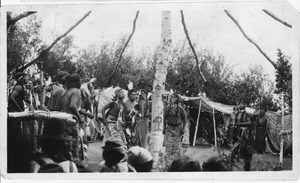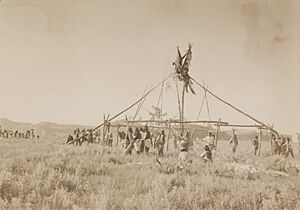Sun Dance facts for kids
The Sun Dance is an important ceremony for many Native Americans in the United States and Indigenous peoples in Canada. It is mostly practiced by groups from the Plains cultures. During this ceremony, communities come together to pray for healing and well-being. Individuals also make personal sacrifices to help their community.
After Europeans came to the Americas, the governments of Canada and the United States made laws to stop Indigenous cultures. They wanted Native people to become more like European settlers. The Sun Dance was one of the ceremonies that was not allowed. Another was the potlatch of the Pacific Northwest peoples.
Canada stopped its ban on the full Sun Dance ceremony in 1951. In the United States, the American Indian Religious Freedom Act (AIRFA) was passed in 1978. This law helped protect the religious rights and cultural practices of Native Americans, Inuits, Aleuts, and Native Hawaiians.
Contents
What is the Sun Dance?
Many Sun Dance ceremonies share similar features. These include:
- Dances and songs that have been passed down for many generations.
- The use of a traditional drum.
- A sacred fire.
- Praying with a ceremonial pipe.
- Going without food and water (fasting) before and during the dance.
- In some cases, a test of physical strength and endurance.
- Special plants are gathered and prepared for the ceremony.
The Sun Dance can be a very challenging experience for the dancers. It is a physical and spiritual test they offer as a sacrifice for their people. Dancers might fast for many days, staying outdoors no matter the weather.
Not all Sun Dance ceremonies include body piercing. However, the main goal of the Sun Dance is for individuals to make personal sacrifices. These sacrifices are made for the good of their family and community.
During most ceremonies, family members and friends stay in a nearby camp. They pray to support the dancers. The entire community puts a lot of time and effort into these gatherings. Communities often plan for at least a year to get ready for the ceremony. Usually, one or a few leaders are in charge, but many elders help and give advice. A group of helpers does many of the tasks needed to prepare.
History of the Sun Dance
For many years, the Canadian government tried to stop the Sun Dance. Government officials often interfered with and discouraged these dances from 1882 until the 1940s.
In 1895, Canada added a rule to its Indian Act. This rule made it illegal to have any celebration or dance that involved "wounding the body of any human being or animal." Anyone who took part, helped, or encouraged such a dance could go to prison. Even though not all First Nations Sun Dances included body piercing, this law made it illegal for those that did.
It's not clear how often this law was actually used. In some cases, police even allowed the ceremony to happen. Many First Nations people simply held their ceremonies quietly and in secret. Groups like the Plains Cree, Saulteaux, and Blackfoot continued to hold Sun Dances during this time. Some did it in secret, others got permission, and some performed it without the body piercing.
In 1951, the government changed the Indian Act. They removed the rule against practices that involved body wounding.
Sun Dance Today
The Sun Dance is still practiced every year in many First Nations communities in Canada. The Cree and Saulteaux have held at least one Rain Dance (which has similar parts) every year since 1880.
In 1993, leaders from Lakota, Dakota, and Nakota nations in the US and Canada met. They felt that the Sun Dance and other sacred ceremonies were being disrespected. About 500 representatives from 40 different groups attended this meeting, called "the Lakota Summit V." They all agreed on a statement called 'Declaration of War Against Exploiters of Lakota Spirituality.'
This statement said that fake "sundances" were being held for non-Indigenous people by people who were not truly spiritual leaders. It declared that they would fight against anyone who misused or misrepresented their sacred traditions.
In 2003, the leader who protects the Sacred White Buffalo Calf Pipe of the Lakota asked non-Indigenous people to stop attending the Sun Dance. He said that everyone can pray to support the ceremony, but only Indigenous people should be near the sacred altars. This idea was supported by other spiritual leaders from the Cheyenne, Dakota, Lakota, and Nakota nations. They announced that non-Indigenous people would not be allowed at sacred altars or in the Seven Sacred Rites, including the Sun Dance, starting March 9, 2003.
They explained that the purpose of the Sun Dance is for the survival of future generations. If non-Indigenous people truly understand this purpose, they will also understand and respect this decision. By leaving the sacred altar, they are contributing to the survival of future generations.
Filming the Ceremony
In most Sun Dance cultures, it is not allowed to film the ceremony or prayers. This is why there are very few pictures or videos of real ceremonies. Many First Nations people believe that when money or cameras are present, the spirits leave. So, no photo can truly show an authentic ceremony.
The Kainai Nation in Alberta, Canada, did allow their Sun Dance to be filmed in the late 1950s. This film became a documentary called Circle of the Sun (1960). Old photos from Manitoba show that these ceremonies have been happening regularly since at least the early 1900s.
See also
 In Spanish: Danza del Sol para niños
In Spanish: Danza del Sol para niños




